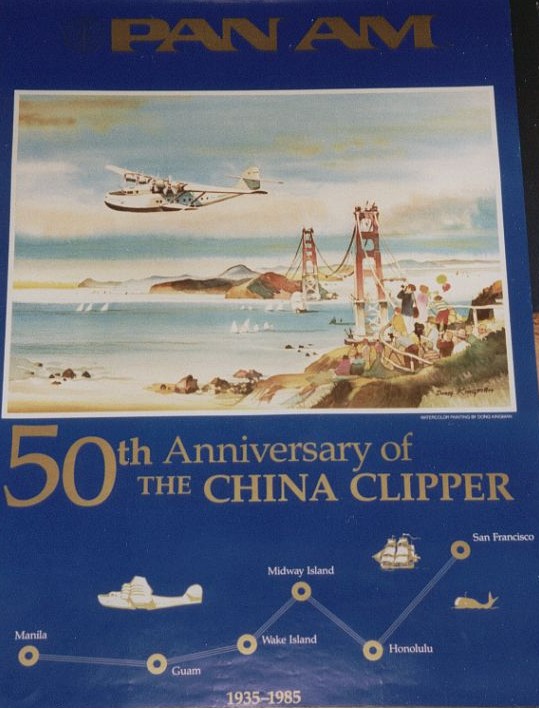Pan Am Posters
In its 64 year existence Pan Am produced hundreds of posters promoting aircraft, service & destinations. What follows below are a sampling of different styles from different eras.
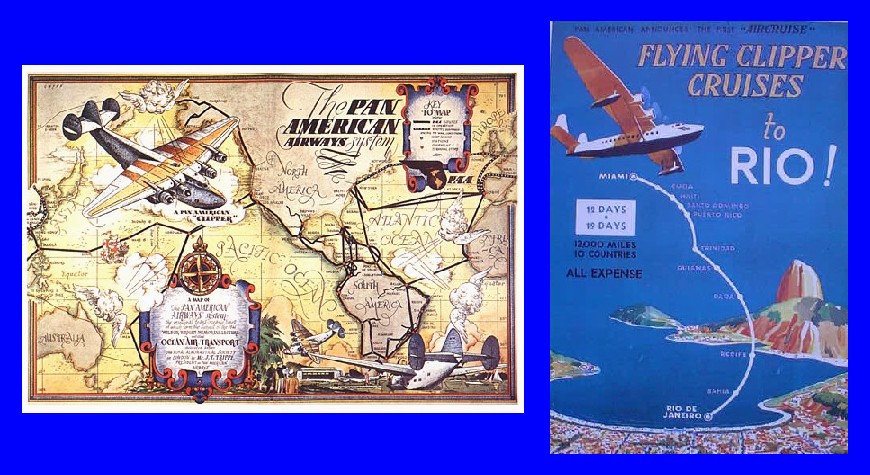
Some early Pan Am posters focused on the company's routes
Just after World War II Pan Am poster art had white boarders and simple art
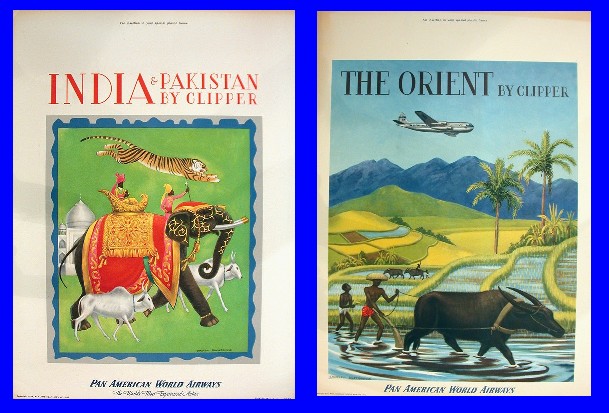
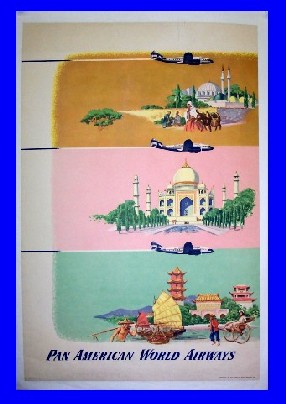
1950s
During the 1950s Pan Am produced some travel posters with very lush and colorful art.

One Pan Am poster campaign of the 1950s featured people of a country with landmarks & popular activities in the background.
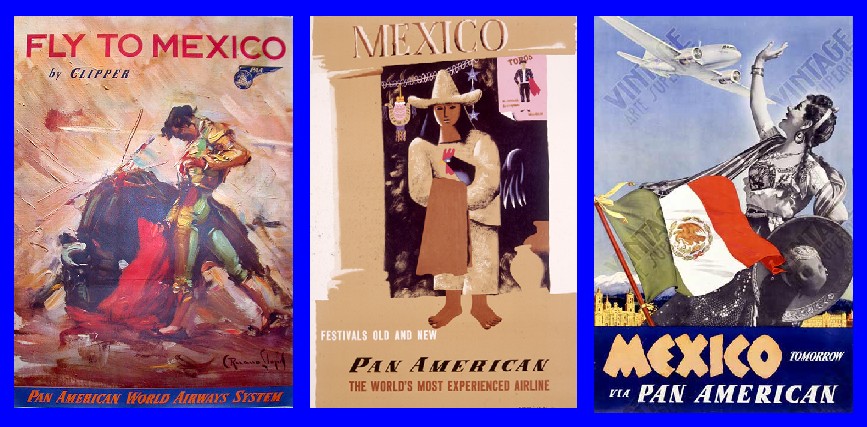
Mexico was always a popular Pan Am poster subject.
Not only was it one of the closest destinations the company served from the United States. It was also very affordable for many Americans.
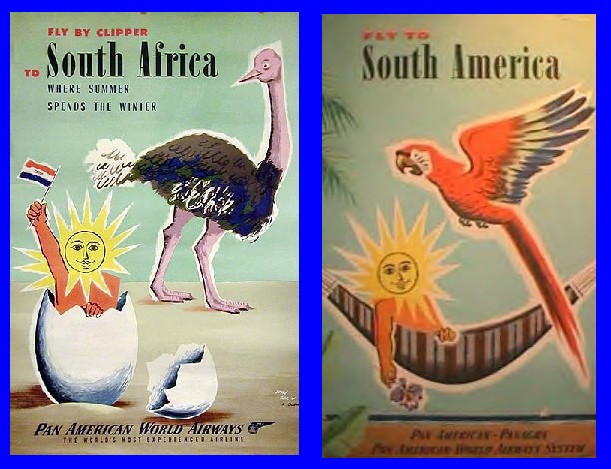
An amusing poster campaign from the 1950s featured little "sun people" to encourage Americans to travel to the Southern Hemisphere during winter in the Northern Hemisphere
Pan Am also created posters to encourage people the world over to visit the USA
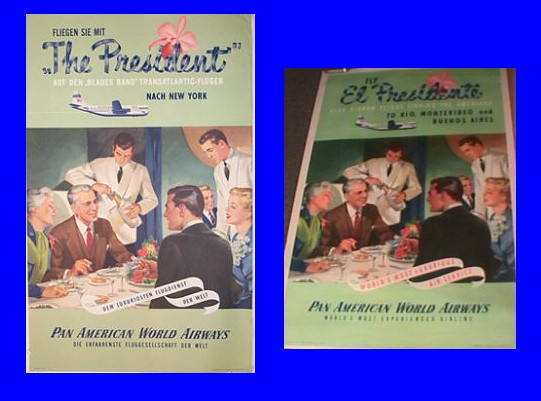
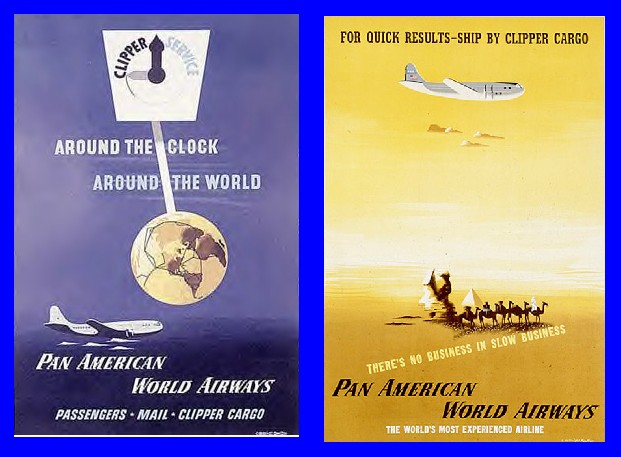
In the 1950s Pan Am's first class service was called "The President" or "El Presidente" to Latin America. Below English & German language posters that depict the opulent meal service aboard the Boeing Stratocruiser's forward stateroom.
Some 1950s posters highlighted Pan Am's Round-the-World service as well as the company's cargo capabilities.

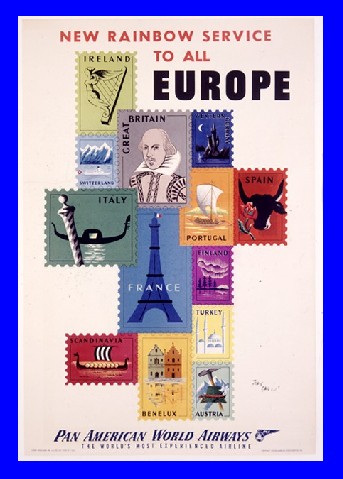
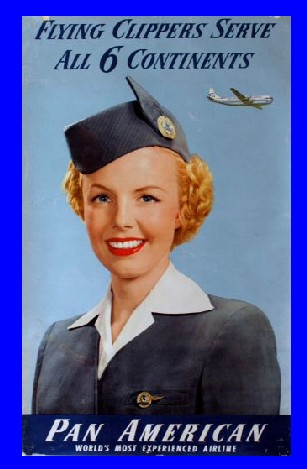
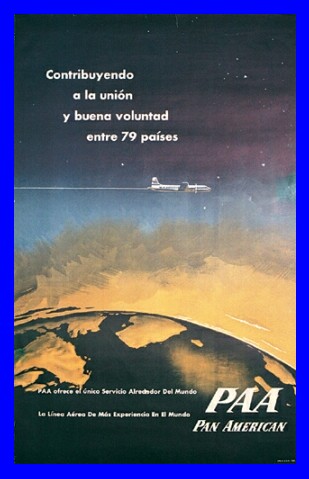
These two 1950s poster promotes Pan Am's Tourist / Economy Class service to Europe. Pan Am was the first airline to lobby for and offer Tourist fares and called the service "The Rainbow." It is unusual to see prices listed on a poster as they changed frequently.
An attractive 1950s era stewardess to welcome you aboard your Flying Clipper
Pan Am always saw itself as a global goodwill ambassador. This 1950s foreign language poster reminds all that Pan Am brought together the people of 79 countries.
Other posters promoted seasonal or special events.
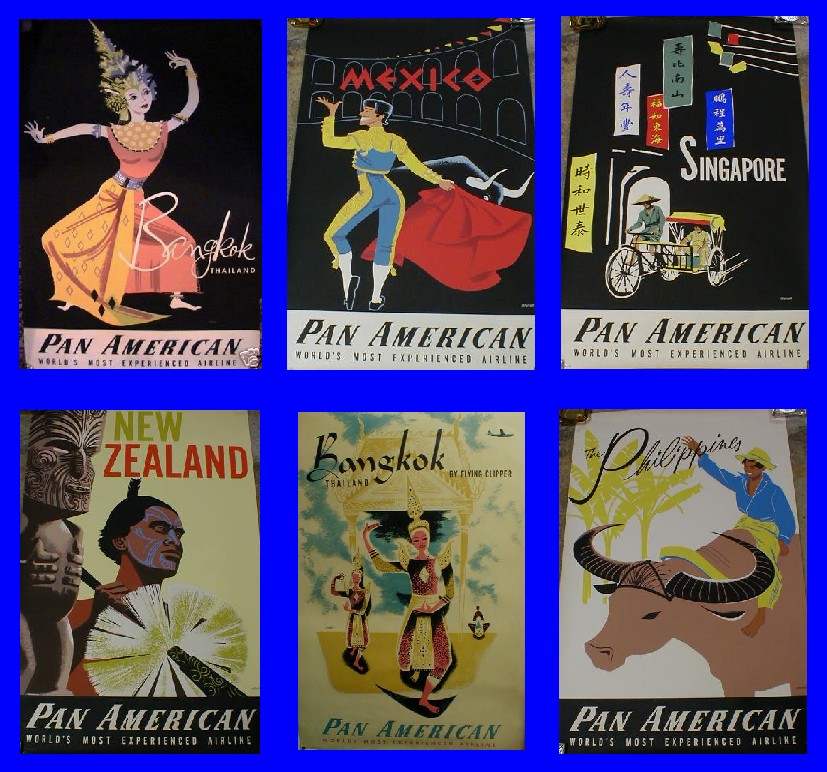
Another style of 1950s posters used black & white backgrounds to offset the artwork.
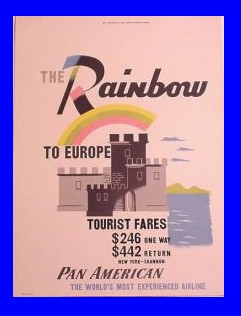
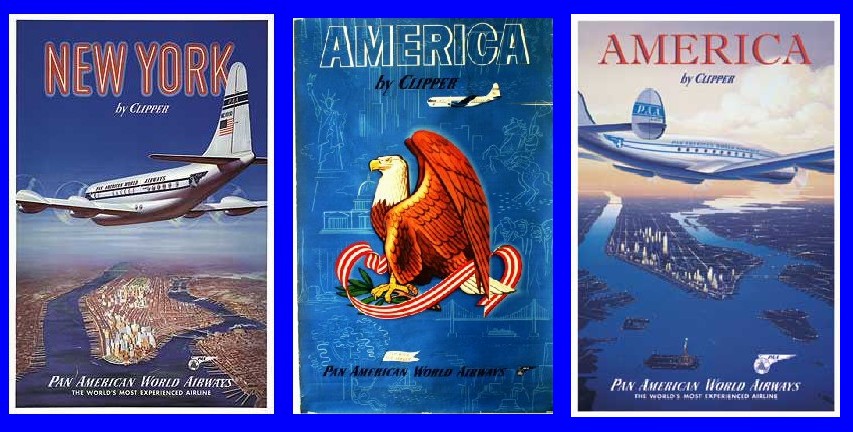

Below are 6 early examples of Pan Am posters from the 1930s & 40s. Note the Havana poster (top left) shows the first version of the Pan Am logo. Note also the Bermuda poster (top center) is in association with Imperial Airways of England. The English would only allow Pan Am access to their markets if Imperial had identical route authority. When service first began from New York to Bermuda Pan Am & Imperial airways each offered one round trip flight per week.

In the late 1950s Pan Am began to produce destination posters that were reproductions of photographs. Seen below are Brazil & Hawaii.
Pan Am inaugurated America's first commercial jet flights on October 26, 1958 with the Boeing 707 on the York - Paris route. Service from New York to London would follow several weeks later Below are some whimsical posters to promote the new jet service. .
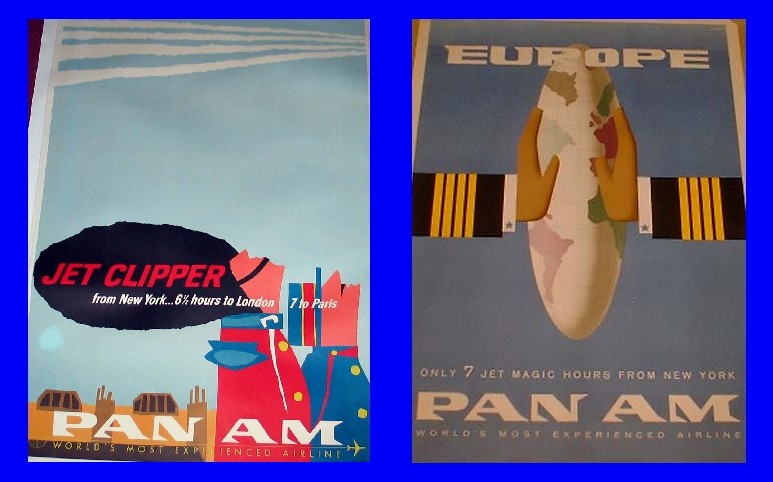
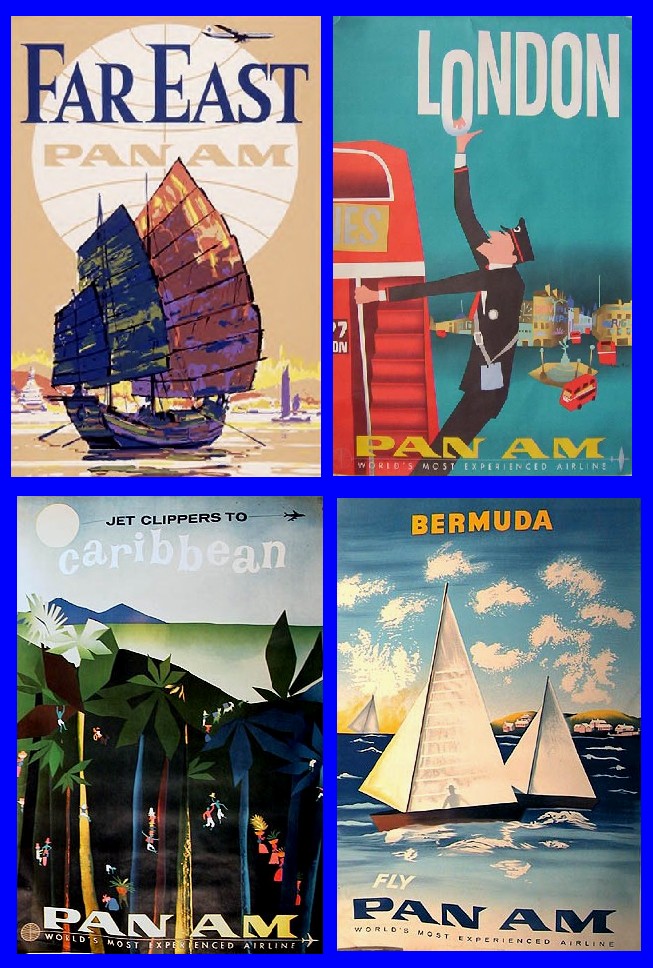
1960s
In the beginning of the 1960s Pan Am would continue to produce art work posters. Seen to the right are 4 examples of early 1960s Pan Am posters.

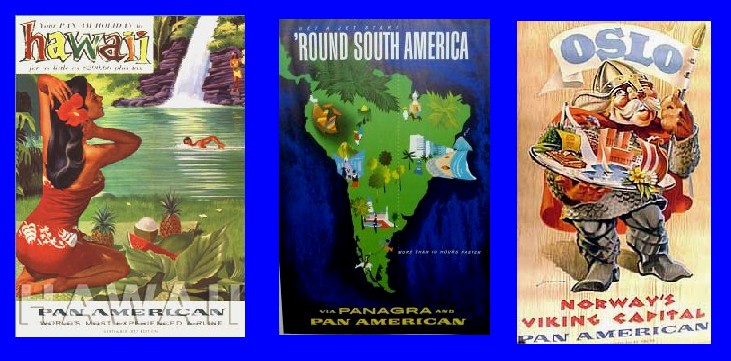
To the left are three more Pan Am posters from the early 1960s
The Hawaii poster below on the left promotes one of Pan Am's many vacation packages to the Islands in the 1960s. In the center a poster promoting the Latin American routes of both Pan Am and sister company Panagra (sold to Braniff in the late 1960s). On the right an unusual poster featuring a caricature of a Viking.
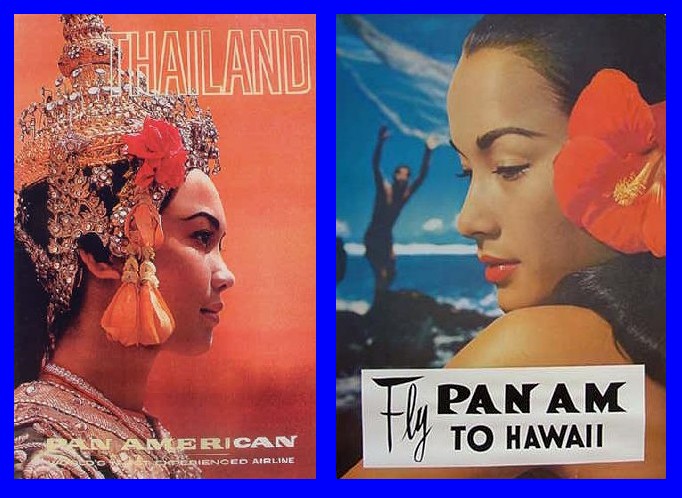
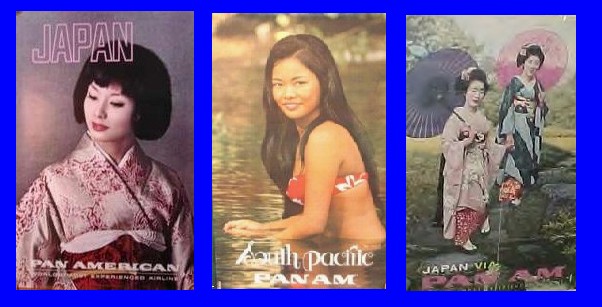
In the 1960s Pan Am also produced posters of beautiful women in native costumes.
..........and three more examples below

Also in the 1960s Pan Am continued to produce posters that were photographs of destinations. The Bahamas poster below was produced jointly with the Tourist Authority of the Islands and that is why the Nation's flag appears on top.

A series of large horizontal posters were produced in the 1960s showing Pan Am destinations with a "Fly Pan Am" banner on the bottom. Below are 6 examples.
In the 1960s Pan Am served Pago Pago, American Samoa as part of its route network to and from Australia & New Zealand with Boeing 707 equipment.
Hong Kong was on Pan Am's "Round-the-World" route from 1947 until the service was suspended in the early 1980s. In the 1960s Pan Am served this English Colony with Boeing 707 service from Tokyo, Manila & Bangkok.
Rio de Janeiro was a Pan Am destination dating back to the 1930s. In the 1960s Pan Am served Rio, Sao Paulo, Brasilia & Belem.
In the 1960s Pan Am served Paris from New York, Washington & Boston. Customers traveling from the west coast of the United States had through plane service via London.
In the 1960s Pan Am served both Madrid & Barcelona from New York. Some service was via Lisbon Portugal. Pan Am had one flight that continued on from Barcelona to both Nice, France and Rome, Italy.
In the 1960s Pan Am offered service to Hawaii from Los Angeles, San Francisco, Portland & Seattle. Pan Am's flights beyond Hawaii fanned out to Japan, the central Pacific via Guam as well as Australia, New Zealand and several South Pacific islands.
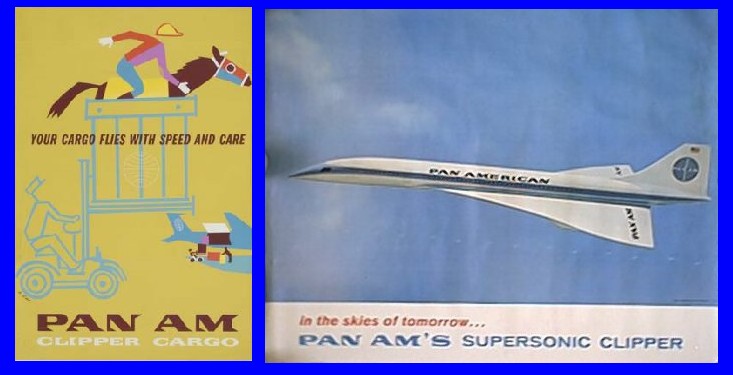
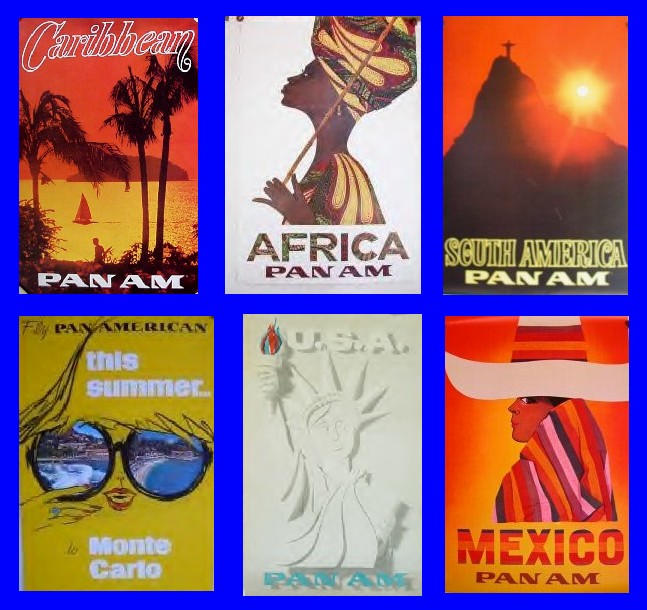
Two specialty 1960s posters are seen below. On the left a cargo poster and on the right a horizontal poster promoting the Super Sonic Transport. Pan Am placed orders for both the Concorde & Boeing SST. However, the environmental movement was growing strong in the second half of the 1960s forcing Boeing to cancel their SST project. The same environmental pressure caused all the US airlines to cancel orders for the Anglo-French Concorde and Pan Am never flew the type.
In the later part of the 1960s Pan Am's posters reflected more of the "groovy" sensibility of the era with lots of oranges & yellows and unusual fonts for text.


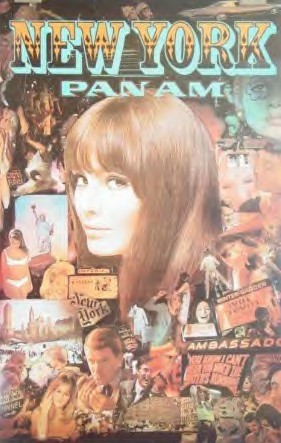
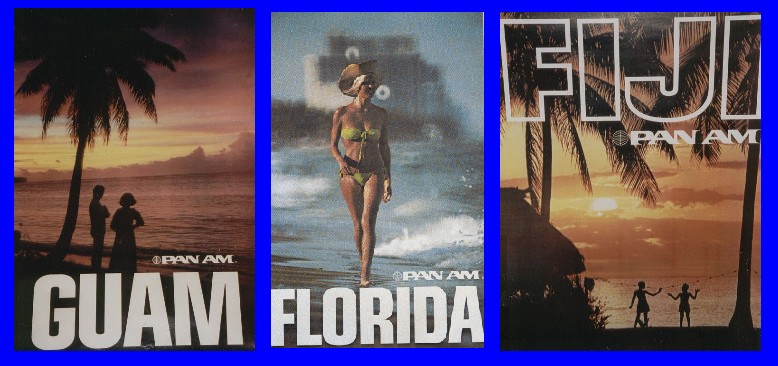
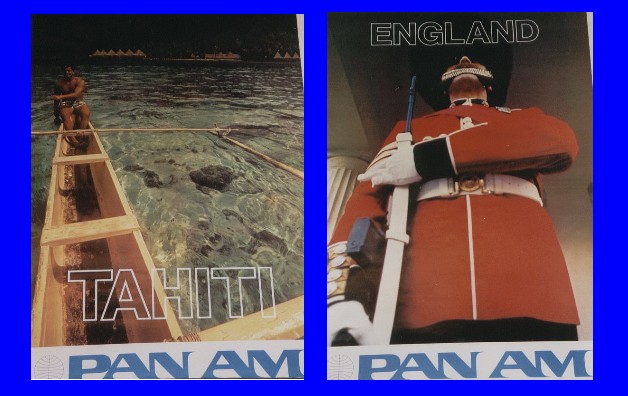
1970s
Pan Am's early 1970s posters reflected the "funky" style of the era. To the left a collage of New York and to the right a "groovy" interpretation of the 747 by pop artist Peter Max. In the 1990s Peter Max would be asked by Continental Airlines to paint one of its Boeing 777s.
Another Pan Am poster campaign from the 1970s shown below featured destination names with overly large fonts.
One Pan Am poster style from the 1970s featured destination names in a hollow white font with the company name and logo in oversized blue at the bottom.
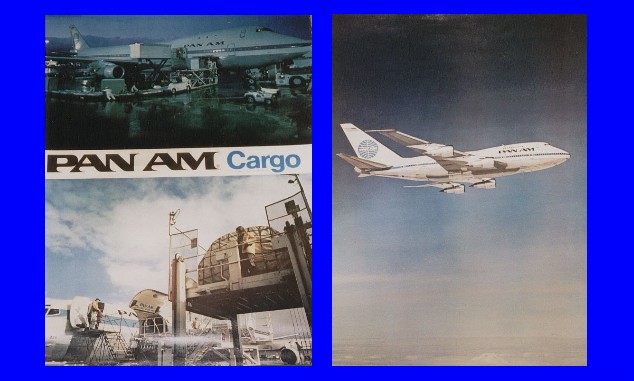
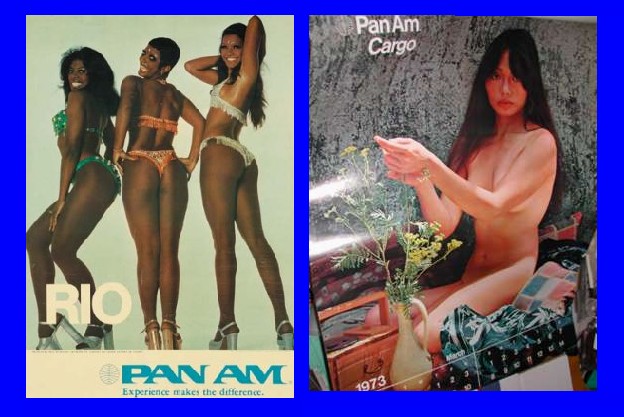
The sexual revolution of the 1970s can also be seen in Pan Am posters. To the left a Pan Am poster celebrating "Carnival" in Rio and beside that a poster sized calendar page from 1973.
Pan Am produced posters of many beauties in the 1970s. Shown to the right a poster promoting cargo aboard both the Boeing 747 & 707.
On the far right a poster of the Boeing 747SP. This aircraft introduced by Pan Am in 1976 enabled the company to fly nonstop from New York to Tokyo, San Francisco to Hong Kong and many other long haul routes.

In the late 1970s Pan Am introduced a new "branding" campaign that placed the company name and logo sideways. This style was used in all advertising and printed material. Below are four examples of posters featuring the sideways logo.
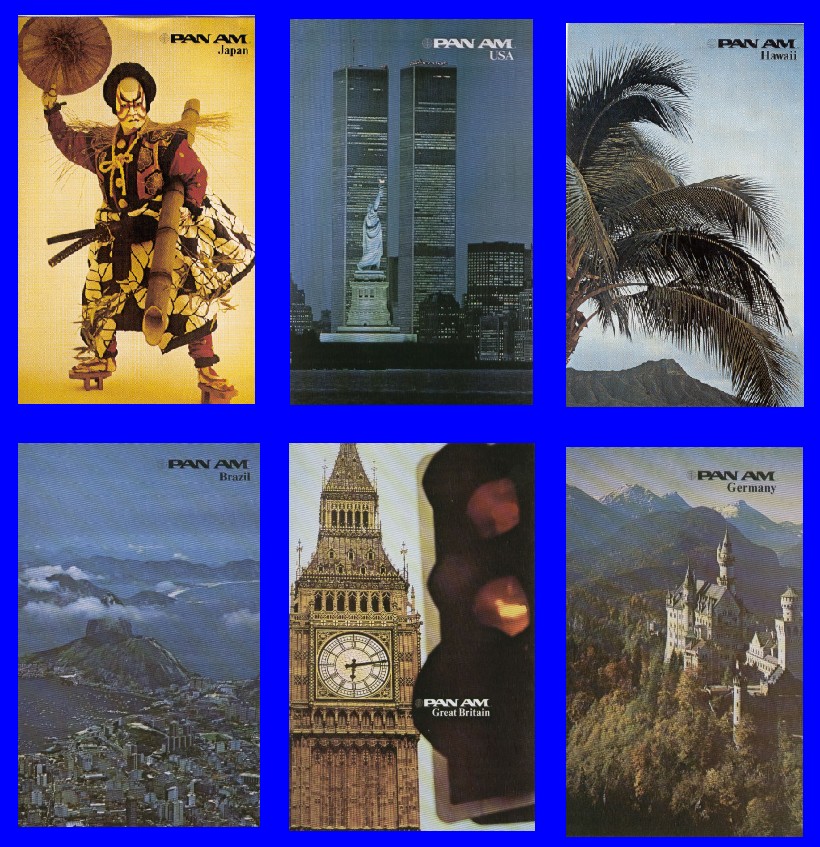
Pan Am's last poster style of the 1970s featured both destination & people images with the company name back in the horizontal position at either the top or bottom of the poster. This style of poster was issued by Pan Am into the early 1980s.
Miniature reproductions of these posters were produced as postcards and available to passengers in-flight. The postcards had a detachable back panel that allowed passengers to purchase the full-size poster via mail order.

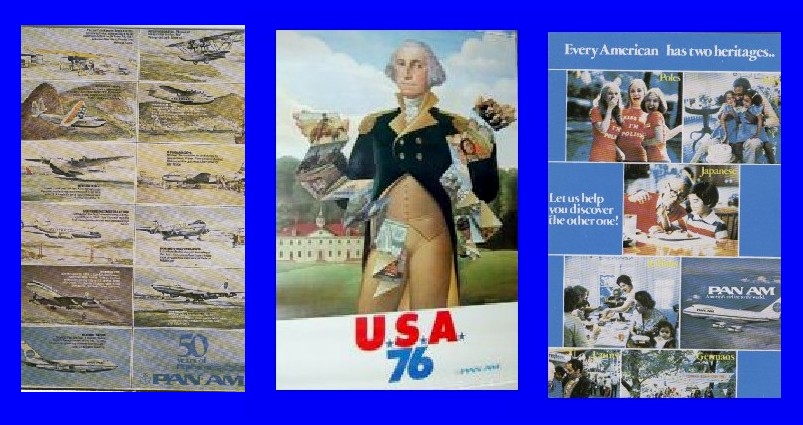
As with all decades Pan Am also issued specialty posters in the 1970s. Below on the left a poster issued in 1977 for Pan Am's 50th Anniversary showing a series of Pan Am "first flights."
In the center, a poster issued in 1976 for the United States Bi-Centennial celebration.
On the right a poster from an award winning Pan Am advertising campaign. This 1977 campaign suggested that "Every American has a second heritage" and suggested Pan Am could help everyone discover theirs.
Prior to Pan Am's "two heritages" campaign the company had a brief & humorous advertising campaign touting Pan Am was the only US carrier that could bring you to 6 of the 7 continents. There were television spots as well as newspaper & magazine ads. Some copy included apologies to the citizens of South Pole for Pan Am's lack of service.

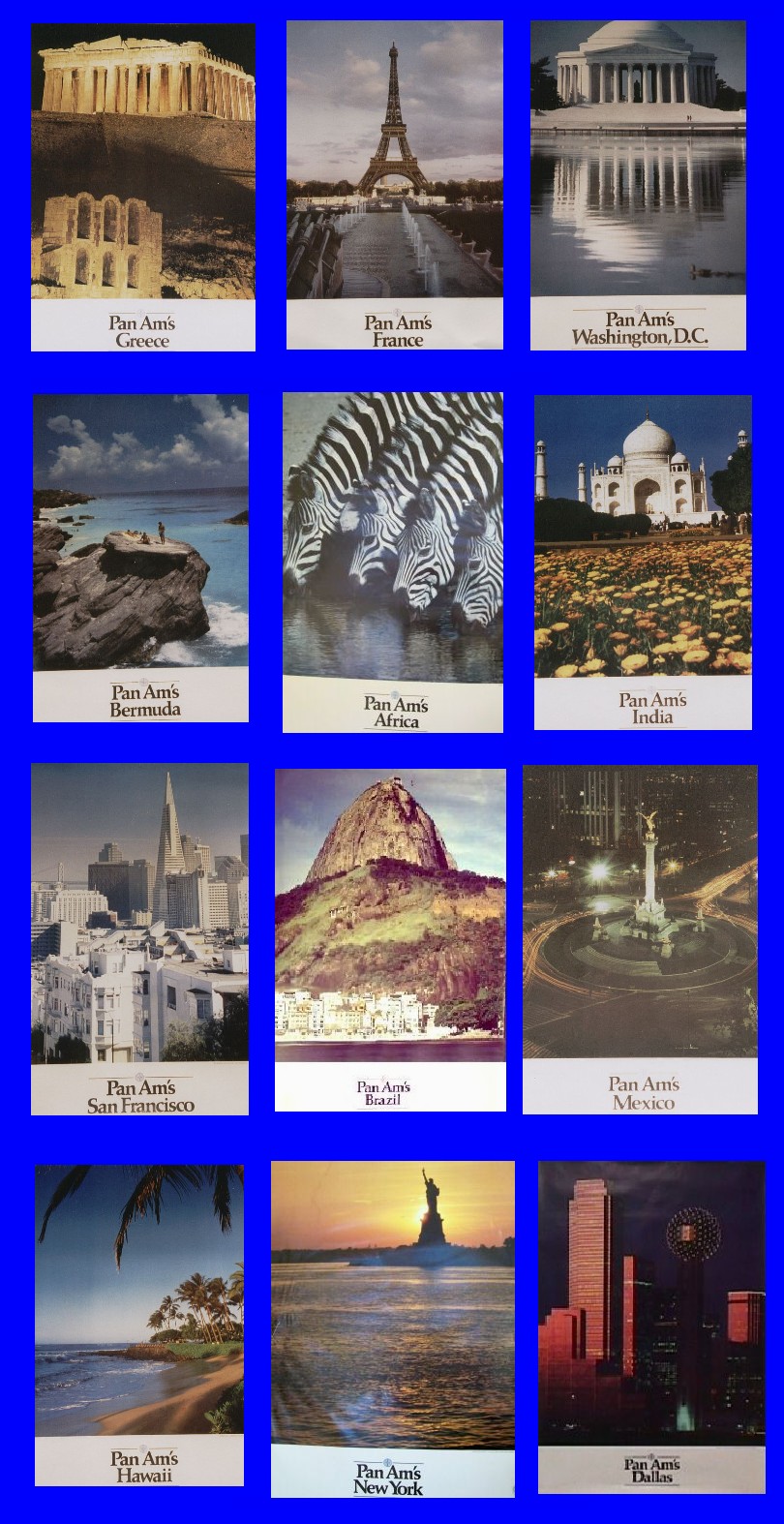
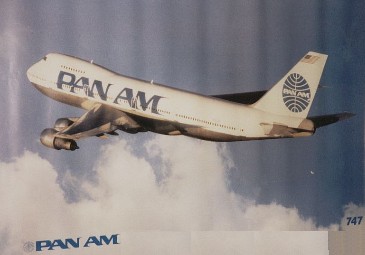
1980s
In the 1982-83 time period Pan Am introduced a poster design featuring destinations & people in each poster. The Pan Am name and logo appeared at the top with a small color bar to attract the eye.
This series was the first produced since the Pan Am - National merger and therefore more US domestic cities in the series.
Sadly, this would be the last series of posters to feature Pan Am's Asia destinations as they would be sold to United Airlines in February of 1986.
After the Pacific Sale to United Pan Am introduced what would be the last series of posters. This set featured destination images with the company name & logo in black on a large white bottom boarder.
Once again in the 1980s Pan Am created posters for special events. On the left is a poster for the 1984 Winter Olympics in Sarajevo, Yugoslavia. Pan Am was the official US Airline for that Olympics. You may click on the image to better see the Pan Am logo in the center of the Olympic logo.
On the right is a poster to commemorate the 50th anniversary of Pan Am's first trans-pacific flight in 1935. The art work was by Dong Kingman who also did a series of menus for Pan Am in the 1980s. Click on the image to better see the route of the original Clipper.
Finally, in 1985 Pan Am adopted a new aircraft livery which featured the company's name in a large "billboard" style. This would be the final Pan Am livery and is the same style used by the Pan Am flying today.
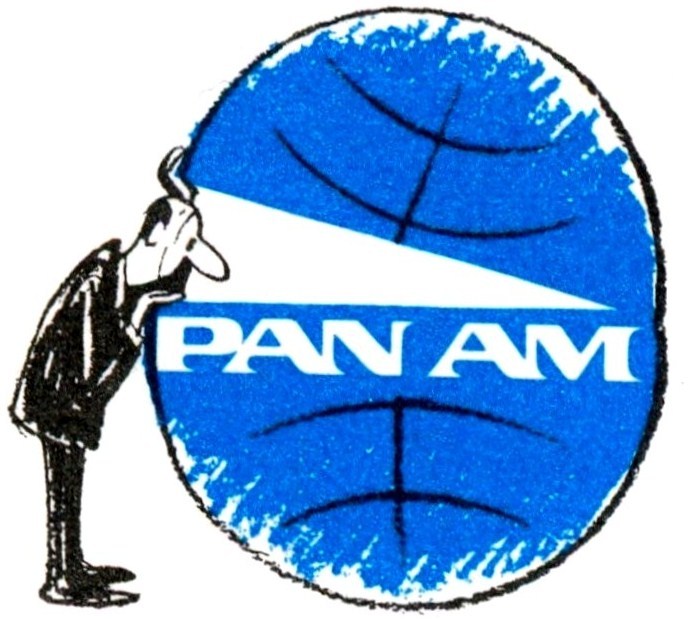
everythingPanAm.com
The Virtual Pan Am Museum
